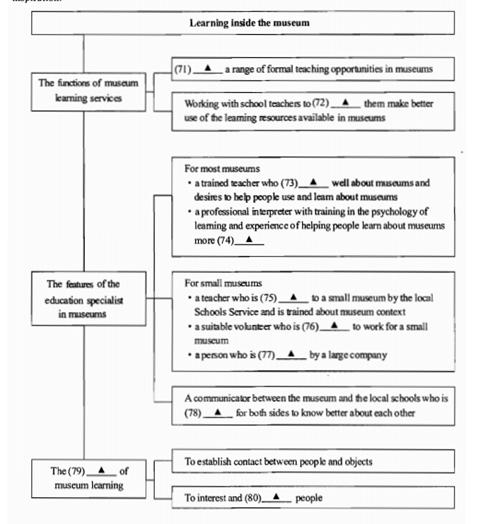写作与表达(共50分)
你是否有一双善于发现的眼睛?
落叶的细语和舞姿,蚂蚁的坚毅和团结;妈妈渐渐花白的鬓发,同学默默努力的身影;社区里大爷大妈的热情,街道上志愿者的奉献,……这些你都发现了吗?
生活中的真、善、美,等待着我们去发现。
请以“发现”为题,写一篇不少于600字的记叙文。文章中不要出现真实的班级名和同学姓名。
参照中考作文评分标准。
作文题为“发现”,该作文题目落实了培养创新精神的要求,并确实达到了“写作不设审题障碍,鼓励学生写真情实感”的目的。
乍一看该题目,你可能一时会感到无素材可写,似乎自己并没有什么新的发现,但如果拓展一下思路,便会发现可写的新内容很多。
1、从父母、师长的爱考虑。很多同学写了这一方面,内容也丰富多彩。如:我发现读懂父亲很难;我发现幸福就在身边;我发现了妈妈(老师)的白发;我发现妈妈很疼我;爱心的发现,等等,题目赋予了内容的多样性,同学们可写出很多感人的文章。
2、从思想行为方面考虑。如:发现做好人真难;我发现我好穷(思想上);良心的发现;我发现能战胜自己,等等。
3、从时间、地点考虑命题。如:12岁的发现;最近的发现;雨中的发现;前天晚上,我发现了彗星,等等。
4、从校园生活考虑命题。如:我发现了校园生活的美;发现落叶;有花有刺——生活中的发现,等等。
5、从科技幻想(梦想)方面考虑。如:不同寻常的发现;偶然的发现;我发现了“新大陆”;21世纪的新发现;我发现了科学的奥妙;意外的发现,等等。

 每个空格只填1个单词。
每个空格只填1个单词。